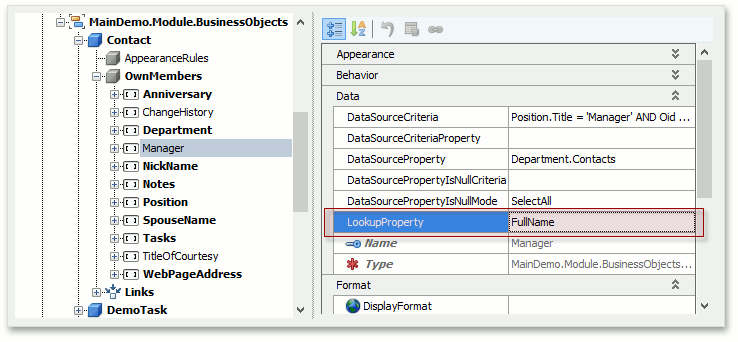How to: Specify a Display Member for a Lookup Editor, Detail Form Caption, and more
- 3 minutes to read
Business classes in your XAF application should have the default member. We recommend that you declare a default property with human-readable values because XAF displays them in the following UI elements:
- Detail View captions
- The first column of List Views
- Lookup List Views
- Lookup Editors in an unexpanded state
If you do not specify the default property, these elements display an object identifier or a class name.
Default Property of a Business Class
This section describes how to declare the default property in your business class. The default property must be declared public and visible (not decorated with the Browsable(false) attribute).
Note that the following sections are arranged in priority order: if you use different techniques in one class, the first described technique determines the default member.
Apply the DefaultProperty or XafDefaultProperty Attribute
Apply the DefaultPropertyAttribute or XafDefaultPropertyAttribute to a business class and pass the default property name as the attribute’s parameter.
using DevExpress.ExpressApp.DC;
// ...
[XafDefaultProperty(nameof(StringProperty))]
public class Task : BaseObject {
// ...
public virtual string StringProperty { get; set; }
// ...
}
// Make sure that you use options.UseChangeTrackingProxies() in your DbContext settings.
Declare a Property with a Specific Name
Declare a property whose name matches or contains one of the DevExpress.ExpressApp.DC.TypeInfo.DefaultPropertyNames values (Name, Title, Subject, Caption, Description, Benennung, Nombre, Nome). In this case, you do not need to apply the attributes described in the section above.
public class Task : BaseObject {
// ...
public virtual string Subject { get; set; }
// ...
}
Note
The DefaultPropertyNames values are arranged in priority order. For example, if a business class has both ObjectName and Description properties, XAF uses ObjectName as the default property.
You can also modify the DefaultPropertyNames collection in the static constructor of the platform-agnostic Module (the MySolution.Module\Module.cs(.vb) file).
using DevExpress.ExpressApp;
using DevExpress.ExpressApp.DC;
// ...
public sealed partial class MySolutionNameModule : ModuleBase {
// ...
static MySolutionNameModule() {
TypeInfo.DefaultPropertyNames.Add("Nombre");
}
}
Apply the FriendlyKeyProperty Attribute
Apply the FriendlyKeyPropertyAttribute to a business class and pass the default property name as the attribute’s parameter.
using DevExpress.ExpressApp.DC;
// ...
[FriendlyKeyProperty(nameof(StringProperty))]
public class Task : BaseObject {
// ...
public virtual string StringProperty { get; set; }
// ...
}
Note
If you do not implement any of the techniques above, XAF uses a key property as the default property.
Property Displayed in a Lookup Property Editor
In the Model Editor, set IModelCommonMemberViewItem.LookupProperty to the property you want to display in a Lookup Editor instead of the default property.
